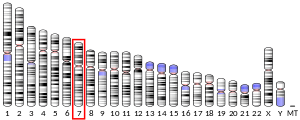Protein pigeon homolog
Protein pigeon homolog also known as gamma-secretase activating protein (GSAP) is a protein that in humans is encoded by the PION gene.[5]
| GSAP | |||||||||||||||||||||||||
|---|---|---|---|---|---|---|---|---|---|---|---|---|---|---|---|---|---|---|---|---|---|---|---|---|---|
| Identifiers | |||||||||||||||||||||||||
| Aliases | GSAP, PION, Protein pigeon homolog, gamma-secretase activating protein | ||||||||||||||||||||||||
| External IDs | OMIM: 613552 MGI: 2442259 HomoloGene: 45504 GeneCards: GSAP | ||||||||||||||||||||||||
| |||||||||||||||||||||||||
| |||||||||||||||||||||||||
| |||||||||||||||||||||||||
| Orthologs | |||||||||||||||||||||||||
| Species | Human | Mouse | |||||||||||||||||||||||
| Entrez | |||||||||||||||||||||||||
| Ensembl | |||||||||||||||||||||||||
| UniProt | |||||||||||||||||||||||||
| RefSeq (mRNA) |
| ||||||||||||||||||||||||
| RefSeq (protein) |
| ||||||||||||||||||||||||
| Location (UCSC) | Chr 7: 77.31 – 77.42 Mb | Chr 5: 21.19 – 21.32 Mb | |||||||||||||||||||||||
| PubMed search | [3] | [4] | |||||||||||||||||||||||
| Wikidata | |||||||||||||||||||||||||
| |||||||||||||||||||||||||
Gene
The human PION gene is located on the long (q) arm of chromosome 7 at band 11.23, from base pair 76,778,007 to base pair 76,883,653.[6] Highly conserved PION orthologs have been identified in most vertebrates for which complete genome data are available.[7] More distantly related orthologs are also expressed in insects including the pigeon gene in Drosophila melanogaster that when mutated produces the "pigeon" phenotype. The name of the human PION gene derives the corresponding Drosophila gene.
| ||||||||||||||||||||||||||||||
Protein
The transcribed human pigeon homolog protein is 854 amino acid residues in length.[8] A 16 kDa fragment (GSAP-16K) derived from 121 residues from the C-terminus region of the full length protein is known as the γ-secretase activating protein (GSAP).[9]
Function
γ-secretase activating protein (GSAP) increases β-amyloid production through a mechanism involving its interactions with both γ-secretase and its substrate, the amyloid precursor protein (APP).[9] By binding to both the γ-secretase enzyme and its APP substrate, GSAP increases the affinity and the selectivity of the enzyme for this particular substrate.
Therapeutic target for Alzheimer's disease
The activating function of GSAP can be inhibited by the anticancer drug imatinib (Gleevec) which in turn prevents γ-secretase from converting APP into plaque forming β-amyloid without affecting the other functions of γ-secretase. Imatinib itself does not get into the brain[10] so imatinib could not be used as an AD therapeutic. However it may be possible to identify imatinib-like drugs that do get into the brain. Hence GSAP represents a potential therapeutic target for the treatment of Alzheimer's disease (AD).[9]
The drug semagacestat in contrast to imatinib, works by directly inhibiting the γ-secretase. While semagacestat reduces β-amyloid plaque formation in AD patients, γ-secretase is also needed to make other important proteins.[11] The failure of semagacestat to improve the cognitive function of AD patients may be due to its non-selective blockade of γ-secretase. The more selective blockade of γ-secretase provided by inhibiting GSAP may make GSAP a more efficacious and safer drug target than γ-secretase.[9]
Discovery
The PION gene was originally discovered through a large scale genome sequencing effort.[12] However the function of the PION gene product remained a mystery. In the laboratory of Paul Greengard, a screen of compounds that could inhibit the formation of β-amyloid identified imatinib,[13] however it was not immediately known how it accomplished this. Later it was discovered by Greengard's lab that imatinib inhibited the function of GSAP and that GSAP in turn functions as an activator of γ-secretase.[9]
References
- GRCh38: Ensembl release 89: ENSG00000186088 - Ensembl, May 2017
- GRCm38: Ensembl release 89: ENSMUSG00000039934 - Ensembl, May 2017
- "Human PubMed Reference:". National Center for Biotechnology Information, U.S. National Library of Medicine.
- "Mouse PubMed Reference:". National Center for Biotechnology Information, U.S. National Library of Medicine.
- "Entrez Gene: pigeon homolog (Drosophila)".
- "Human chr7:76778007-76883653". UCSC Genome Browser.
- HomoloGene: 45504
- UniProt: A4D1B5
- He G, Luo W, Li P, Remmers C, Netzer WJ, Hendrick J, Bettayeb K, Flajolet M, Gorelick F, Wennogle LP, Greengard P (September 2010). "Gamma-secretase activating protein is a therapeutic target for Alzheimer's disease". Nature. 467 (7311): 95–8. doi:10.1038/nature09325. PMC 2936959. PMID 20811458. Lay summary – New York Times.
- Dai H, Marbach P, Lemaire M, Hayes M, Elmquist WF (March 2003). "Distribution of STI-571 to the brain is limited by P-glycoprotein-mediated efflux". The Journal of Pharmacology and Experimental Therapeutics. 304 (3): 1085–92. doi:10.1124/jpet.102.045260. PMID 12604685.
- St George-Hyslop P, Schmitt-Ulms G (September 2010). "Alzheimer's disease: Selectively tuning gamma-secretase". Nature. 467 (7311): 36–7. doi:10.1038/467036a. PMID 20811445.
- Strausberg RL, Feingold EA, Grouse LH, Derge JG, Klausner RD, Collins FS, et al. (December 2002). "Generation and initial analysis of more than 15,000 full-length human and mouse cDNA sequences". Proceedings of the National Academy of Sciences of the United States of America. 99 (26): 16899–903. doi:10.1073/pnas.242603899. PMC 139241. PMID 12477932.
- Netzer WJ, Dou F, Cai D, Veach D, Jean S, Li Y, Bornmann WG, Clarkson B, Xu H, Greengard P (October 2003). "Gleevec inhibits beta-amyloid production but not Notch cleavage". Proceedings of the National Academy of Sciences of the United States of America. 100 (21): 12444–9. doi:10.1073/pnas.1534745100. PMC 218777. PMID 14523244.
Further reading
- Oh JH, Yang JO, Hahn Y, Kim MR, Byun SS, Jeon YJ, Kim JM, Song KS, Noh SM, Kim S, Yoo HS, Kim YS, Kim NS (December 2005). "Transcriptome analysis of human gastric cancer". Mammalian Genome. 16 (12): 942–54. doi:10.1007/s00335-005-0075-2. PMID 16341674.



